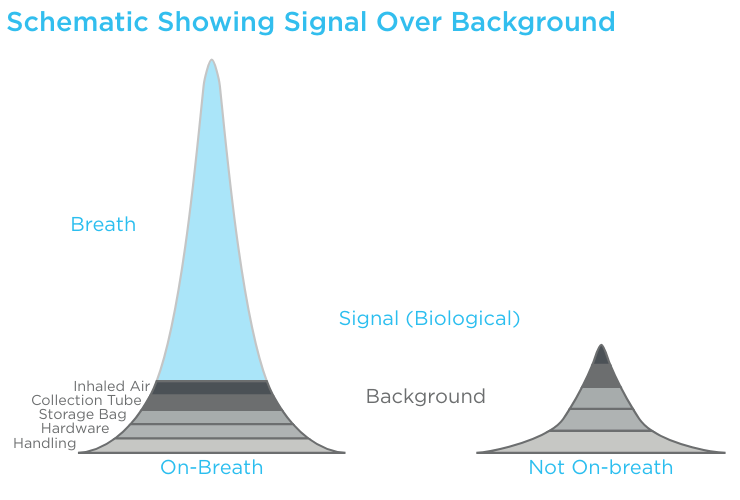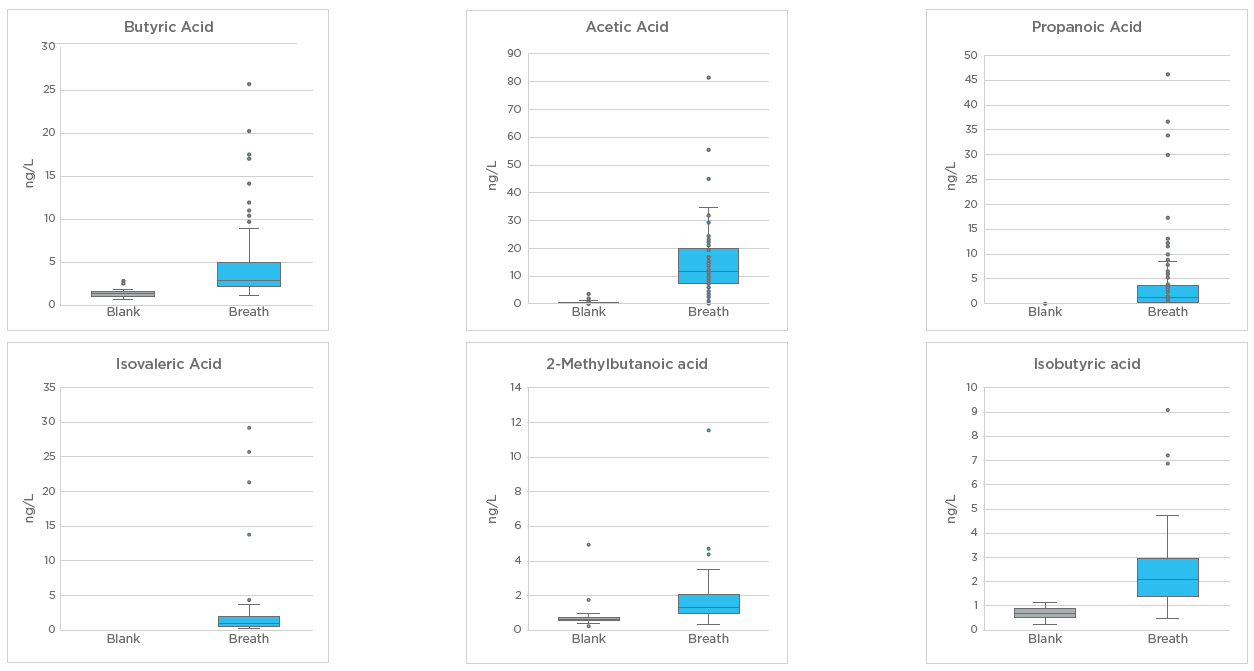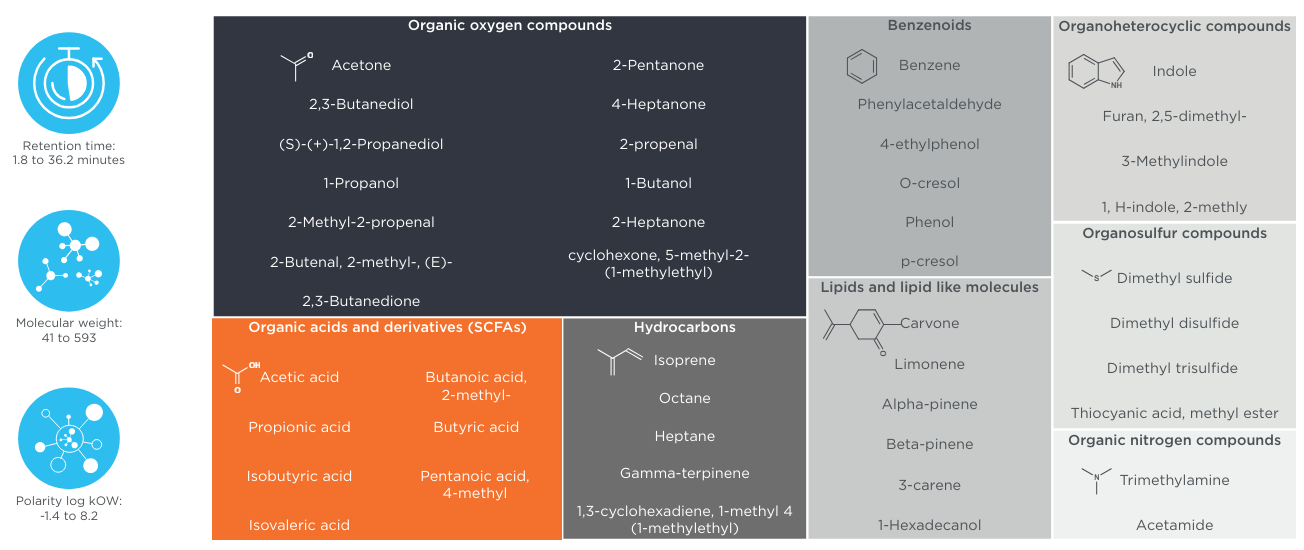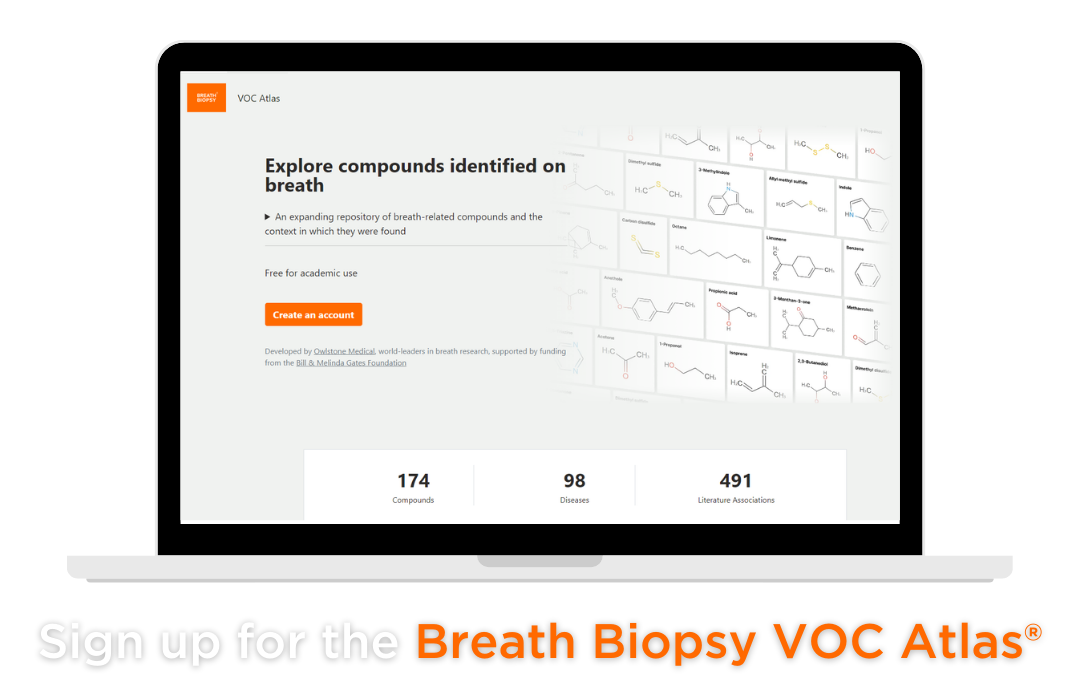New VOC Atlas to Aid Gut Microbiome Research
Published on: 1 Jul 2024
Owlstone Medical’s Breath Biopsy® VOC Atlas aims to produce a comprehensive catalog of chemically identified volatile organic compounds (VOCs) detectable in the breath, alongside reference ranges for their abundance in different populations. Due to the complex composition of the breath matrix, identification and validation of on-breath VOC biomarkers can be challenging. Traditionally, an untargeted approach has been used to discover novel breath biomarkers of disease, often without adequate controls, and without confident chemical identification of VOCs. This has likely resulted in many incorrect or tentative chemical identifications, reducing the ability to compare breath results and ultimately progress biomarkers to clinical use.
To overcome challenges in data collection and analysis, Owlstone Medical has developed Breath Biopsy® technology which can result in dependable data and reproducible analysis. With the help of this technology, we are building what is currently the largest available data set of on-breath VOCs in the world, known as the VOC Atlas. Whilst initial studies focused on a healthy cohort, we have since increased the capacity of the Atlas to also contain a range of contexts including diseased cohorts. This foundational catalog allows researchers to search for a growing number of compounds found in the breath and read about the scientific context of these molecules from the literature, including the biochemical pathways that produce them, and which metabolic processes in the body they are linked to. This allows for data comparison across studies to:
- Better understand biological pathways that produce VOCs detectable in breath
- Cross-validate results to accelerate biomarker development
- Chose optimal sampling and analytical methods
- Optimize VOC analysis platforms and assays
The VOC Atlas can serve as a useful reference database for studying the microbiome, as many of the on-breath VOCs have been identified to originate from microbial sources: including short-chain fatty acids (SCFAs), indole, and trimethylamine (TMA). The Atlas conveniently provides reference ranges for key microbial metabolites in healthy and diseased cohorts, aiding clinical study design. If you are interested in microbial metabolites, you can read about our study designed to characterize microbiome-associated VOCs from human breath below.
Julia Greenwood from Owlstone Medical recently presented at the Breath Biopsy Conference 2024, on ‘Volatile Biomarker Discovery and the VOC Atlas’. You can watch her talk on-demand, as well as the other presentations from the conference here.
Watch the demo video to see how you could use the VOC Atlas (please note: only preliminary data is included).
Case Study: Microbiome Research
By utilizing matched breath and background samples, we conducted an internal study aimed at defining on-breath microbiome-associated VOCs present above background levels and establishing ranges for them in both healthy and diseased populations.
Study Design
170 adult volunteers were enrolled in two projects, one was a healthy cohort and the second cohort had a metabolic disease. All breath samples were collected using Owlstone Medical’s Breath Biopsy® technology. A total of 160 equipment blanks were also collected to allow removal of atmospheric variability in the breath samples.
The samples were analyzed using thermal desorption – gas chromatography-mass spectrometry (TD-GC-MS). To identify a feature as on-breath, it must pass at least one of the following three criteria:
- Sample signal > mean plus 3 standard deviations of background in at least 50% of breath samples.
- Paired t-test with p values <0.05 and fold change > 2 with time-matched blank samples.
- ROC-AUC > 0.8 and a positive mean fold change between breath and blank.
Results & Discussion
In the first study, 1471 total features were identified in breath samples. Of these, 585 were deemed to be on-breath by any of the 3 criteria and 328 were on-breath by all 3 criteria. In the second study, 1267 total features were identified in breath samples. Of these 391 were on-breath by any of the 3 criteria and 188 were on-breath by all 3 criteria. In Figure 2, a selection of microbiome-associated VOCs is shown, with a comparison to blank samples on the left-hand side of each boxplot.

Figure 1: Schematic of Sample Signal Over Background

Figure 2: Boxplots of six SCFAs present on-breath. These were detected at levels significantly above background signals with details recorded in the VOC Atlas.
Out of all the on-breath features recognized, 47 microbiome-associated VOCs were identified by comparison to purified chemical standards. Figure 3 summarizes these compounds, reflecting multiple chemical classifications (on the right) and chromatographic properties (on the left). As additional VOCs are added to the Atlas, categories will expand.

Figure 3: Microbiome-associated VOCs currently in the Atlas.
SCFAs are a key subset of microbiome-associated VOCs relevant to human health and well-being. They are produced via the fermentation of dietary fiber by the microbiota that colonizes the colon (gut microbiome). In this study, compounds such as acetic acid, butyric acid, and propionic acid were reliably detected (see figure 2). These are markers of microbial metabolism, which could greatly inform gastrointestinal research.
There are many possibilities for microbiome-related analysis using breath. For example, a study comparing the digestion of maltodextrin (placebo) with chitin-glucan (an insoluble dietary fiber) found a significant increase in exhaled butyrate on the days of the chitin-glucan ingestion (1). This analysis also revealed five other VOCs of microbial origin, including 2,3-butanedione and 3-hydroxybutanone.
Other gut microbiome-associated VOCs are indoles, which are linked to inflammation and to maintaining the intestinal barrier (2). In a study by Smolinksa et al., VOC metabolites acetate and propionate (the conjugate bases of acetic and propionic acid respectively) correlated significantly with bifidobacteria in subjects with Crohn’s disease (3). Moreover, these microbial strains and the relative abundances of SCFAs both decreased in the active disease state. Trimethylamine (TMA) is another VOC that has been linked more directly heart disease via trimethylamine N-Oxide (TMAO) (4). TMAO can promote the release of inflammatory cytokines, enhance the monocyte adhesion to the endothelial cells, and promote oxidative stress (4). More information about these VOCs can be found in the VOC Atlas, fill in our waitlist form to be the first to know when access is available.
Conclusions
This study demonstrates the diverse range of microbiome-associated VOCs that can reliably be found in the breath. Due to the highly connected nature of the microbiome and the immune system, there is a large potential for microbiome-associated VOC analysis to aid the advancement of medical research. The dynamic nature of the ever-expanding VOC Atlas makes it a useful tool to facilitate further VOC biomarker discovery as well as serve as a foundation for the comparison of healthy and diseased individuals using our comprehensive suite of reference ranges. Furthermore, alongside other tools such as metagenomics and inflammation profiling, the Atlas could provide a more holistic view of the role of the gastrointestinal microbiome in disease development.
Using the Breath Biopsy® VOC Atlas alongside our OMNI® platform allows for a streamlined study design to accelerate biomarker discovery. The ability to reliably detect microbiome-associated VOCs, paired with a curated repository of VOCs found on-breath could transform microbiome research. This is your chance to get involved.
Please contact us if you are interested in using the VOC Atlas and other Breath Biopsy products and services as part of your research studies. Please note that the Atlas is still in development and is currently only available internally at Owlstone.
References
- Neyrinck AM, Rodriguez J, Zhang Z, Seethaler B, Mailleux F, Vercammen J, et al. Noninvasive monitoring of fibre fermentation in healthy volunteers by analyzing breath volatile metabolites: lessons from the FiberTAG intervention study. Gut Microbes. 2021 Jan 1;13(1):1862028. doi: 10.1080/19490976.2020.1862028
- Ye X, Li H, Anjum K, Zhong X, Miao S, Zheng G, et al. Dual Role of Indoles Derived From Intestinal Microbiota on Human Health. Front Immunol. 2022;13:903526. doi: 10.3389/fimmu.2022.903526
- Smolinska A, Tedjo DI, Blanchet L, Bodelier A, Pierik MJ, Masclee AAM, et al. Volatile metabolites in breath strongly correlate with gut microbiome in CD patients. Anal Chim Acta. 2018 Sep 26;1025:1–11. doi: 10.1016/j.aca.2018.03.046
- Liu Y, Dai M. Trimethylamine N-Oxide Generated by the Gut Microbiota Is Associated with Vascular Inflammation: New Insights into Atherosclerosis. Mediators Inflamm. 2020;2020:4634172. doi: 10.1155/2020/4634172


